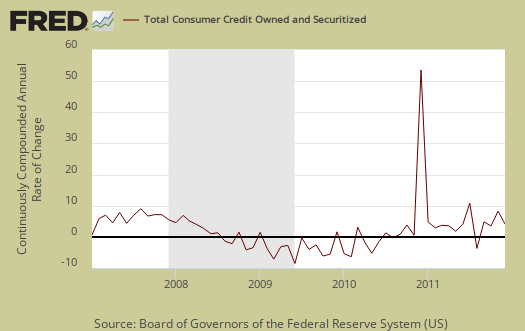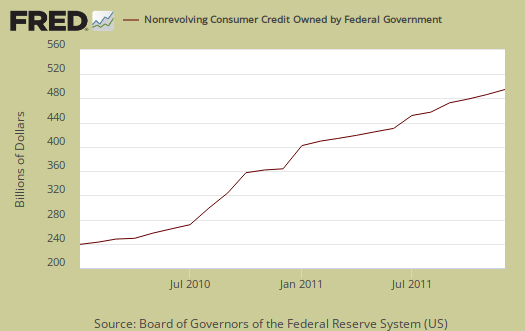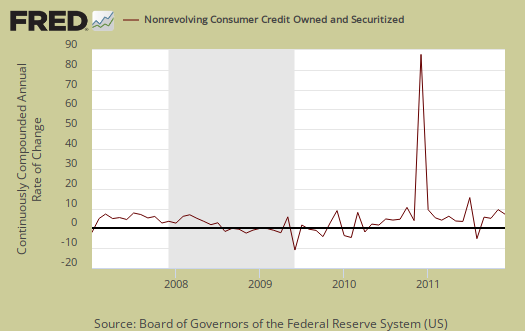The Federal Reserve's consumer credit report for December 2011 shows a 9.3% monthly increase in consumer credit. Revolving credit increased 4.1%, and nonrevolving credit increased 11.8%. The Credit Kraken is clearly on a rampage, for the second month is a row.

Overall consumer credit increased $19.3 billion dollars to $2498.3 billion. Revolving credit increased $2.8 billion while non-revolving increased $16.5 billion. Revolving credit are things like credit cards and non-revolving are things like auto loans and student loans. Mortgages are not included in this report.
The report gives percent changes in simple annualized rates, also known as a continuously compounded annualized rate of change. To put this change in perspective, at simple annualized rates, consumer credit increased almost to this level in the last 10 years. Consumer credit, annualized, increased 9.3%, in September 2004, 9.2% in October 2004, 9.2% in February 2002 and 18.2% in November 2001. Below is the graph of the monthly annualized percentage changes in consumer credit going back to 1980.

From the above graph we can see outstanding consumer credit drops correlate to recessions. This report does not include charge offs and delinquencies, which hit record lows in December:
US credit card charge-offs declined by 34 basis points in December to 5.04%, according to Moody's Credit Card Indices. Also during December delinquencies fell to new record lows, pointing to further declines in charge-offs in the months ahead.
Below is total consumer credit.

The increase was in large part due to student loans. Federal government nonrevolving credit, which includes student loans increased $8.8 billion to 425.1 billion. Tuition has soared this fall, 8.3% at public colleges alone. The federal government started making 100% of guaranteed student loans in July 2010. People went more into debt, clearly, to pay for the soaring, absurdly high, educational costs. These are aggregates, but it's doubtful that the U.S. population entering into college is directly proportional to these monthly increases, especially in December, not a college enrollment month.

Auto loans also did well with auto sales increasing overall 10% in 2011. Below is non-revolving credit, seasonally adjusted, annualized percentage change. This is the biggest monthly increase in nonrevolving credit since November 2001.

Revolving credit, think credit cards, are also up for December. Below is revolving credit, raw totals. Charge offs are not included in this report. These numbers are seasonally adjusted.

Other press claimed the increase is due to a better economy. Sorry folks, people don't go into more debt unless they have to, although offering up more debt implies banks think people can pay it back. Students who have reasonable tuition and can get part-time jobs don't go into absurdly high debt. Parents who have careers and savings to help their kids pay for college don't go into debt either.

Recent comments